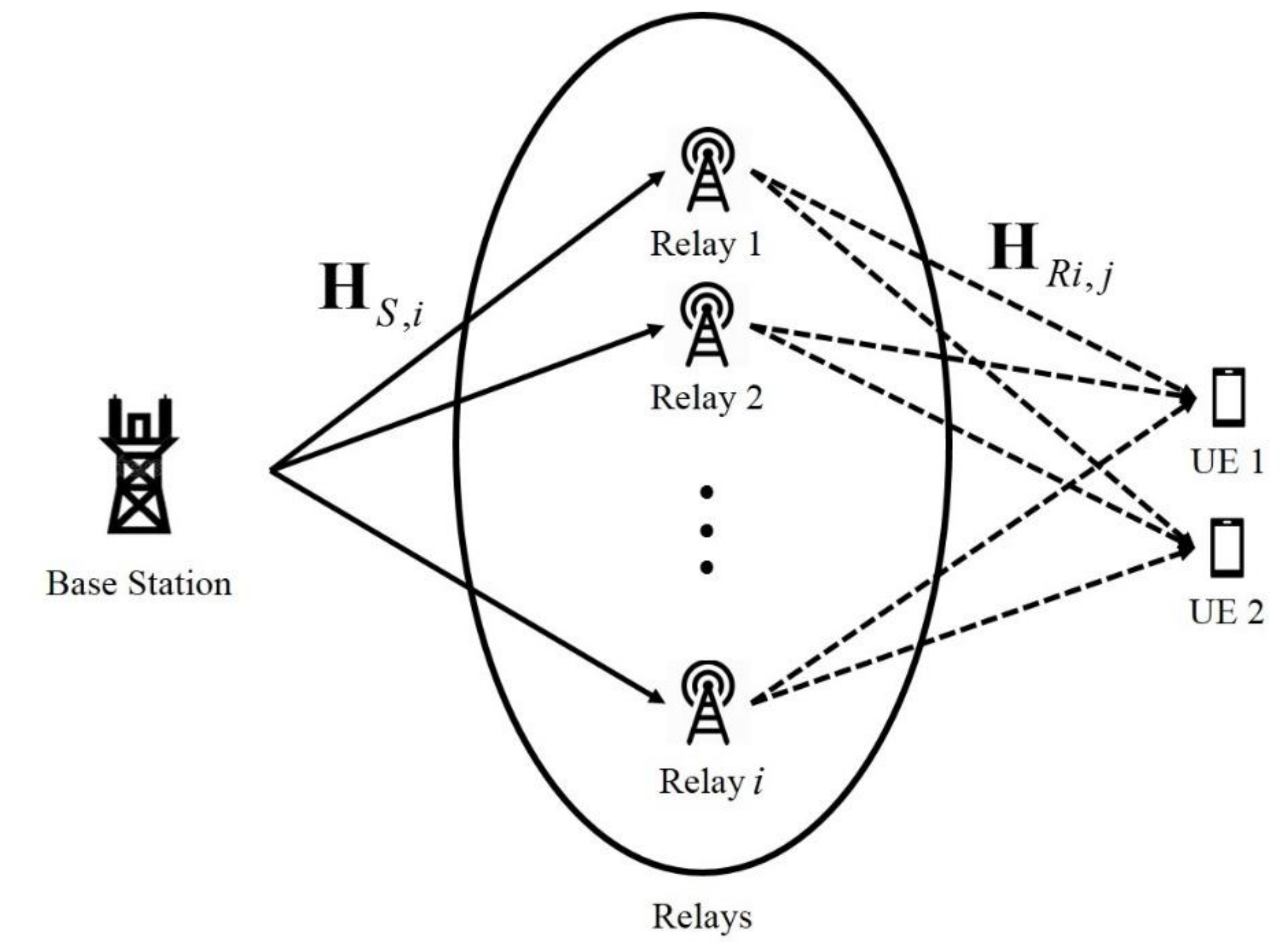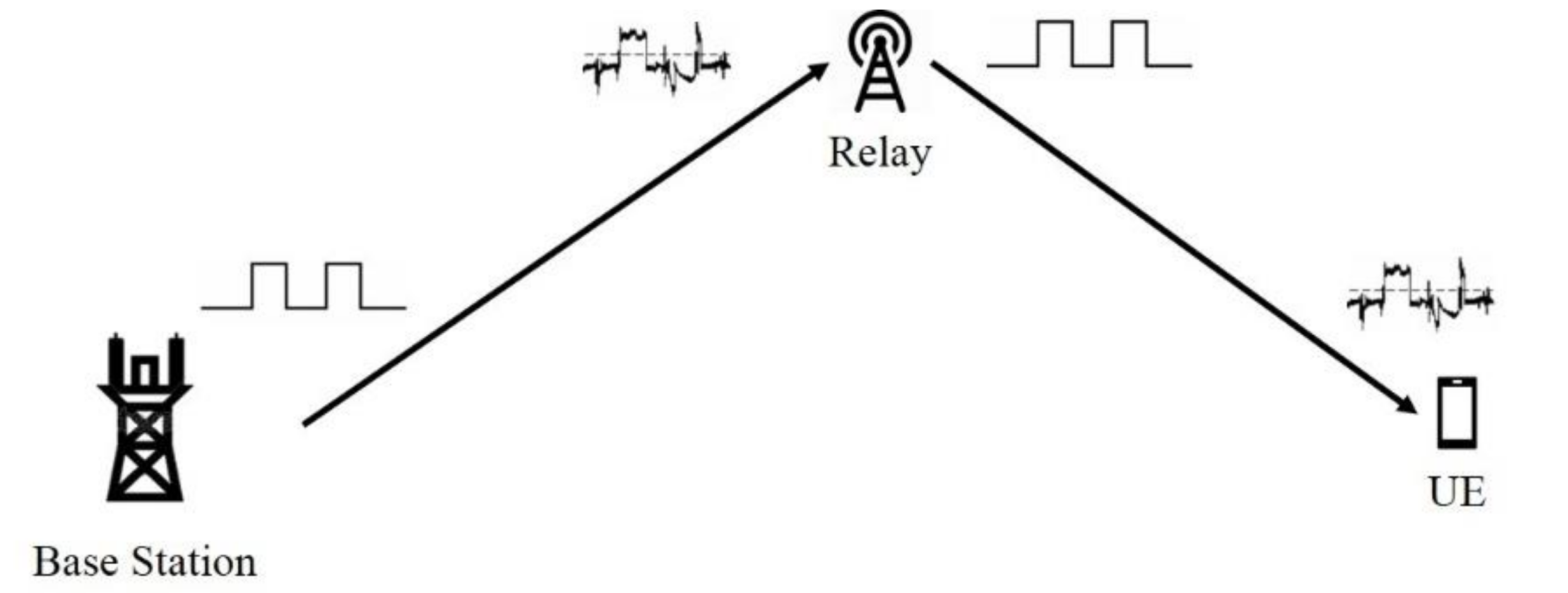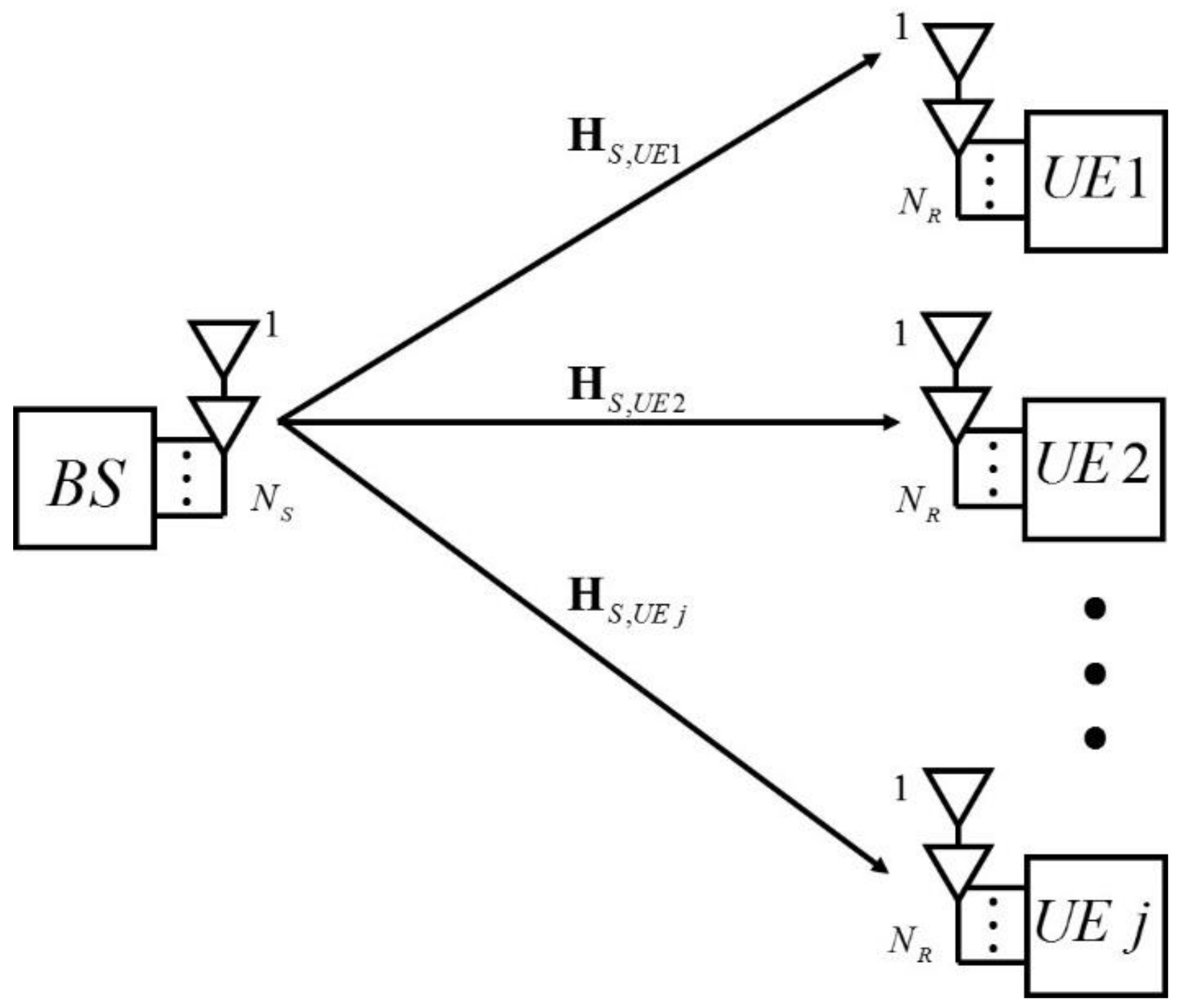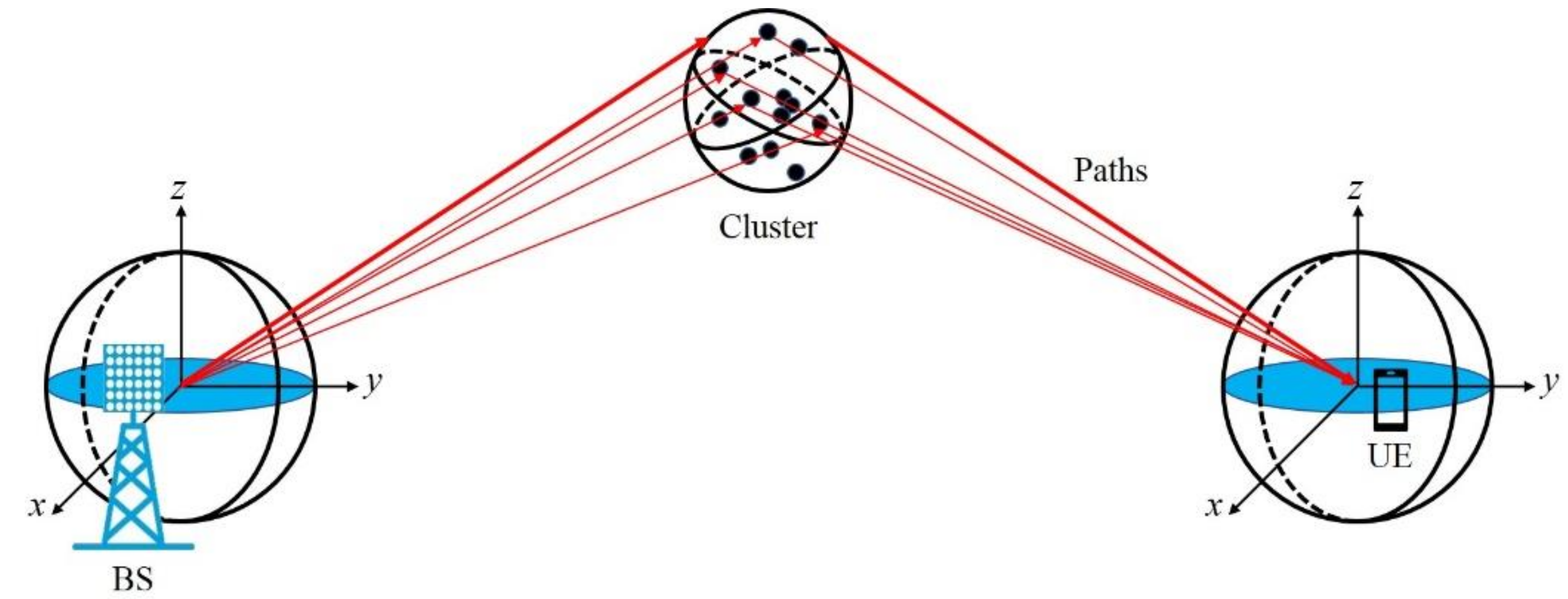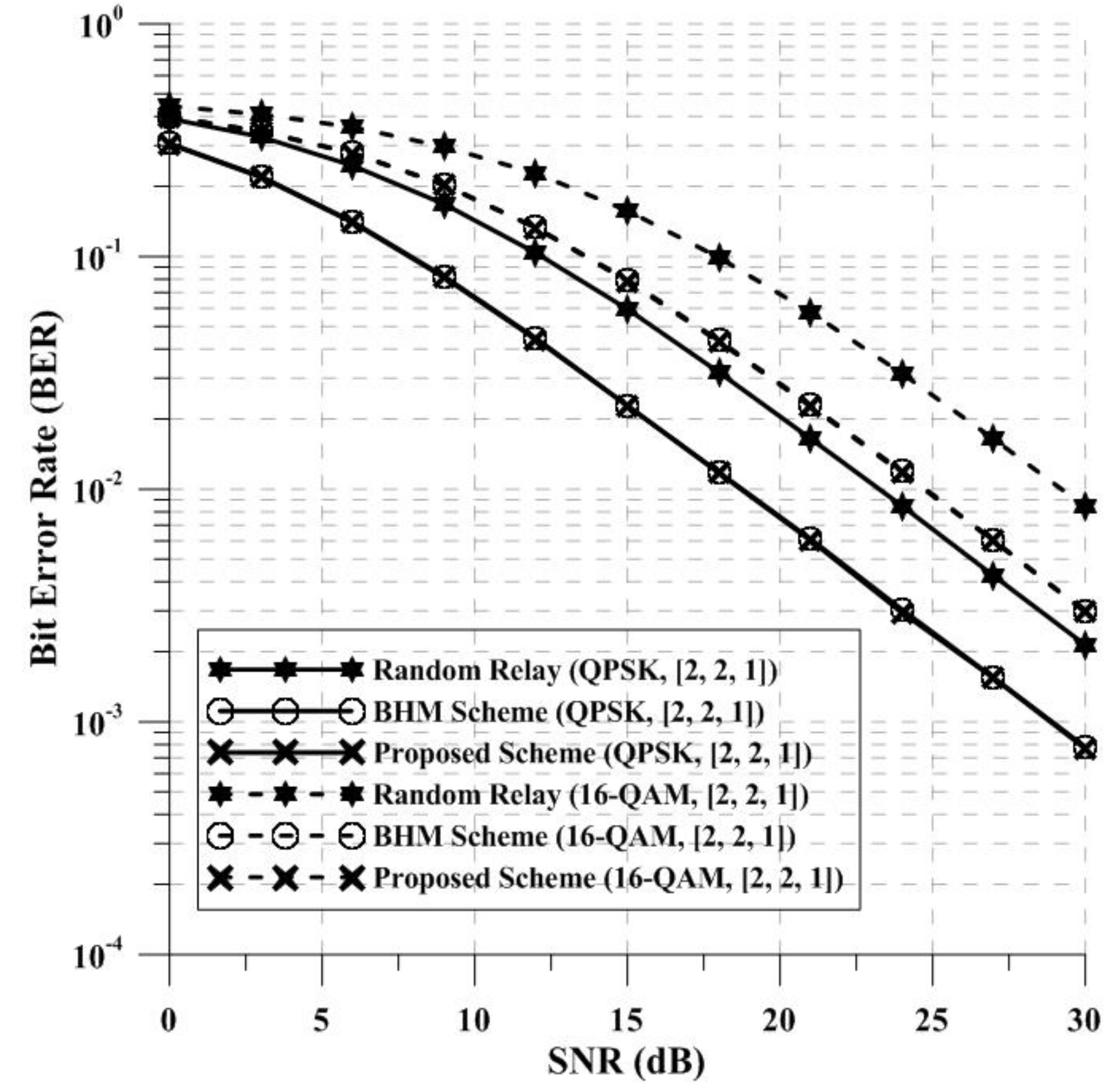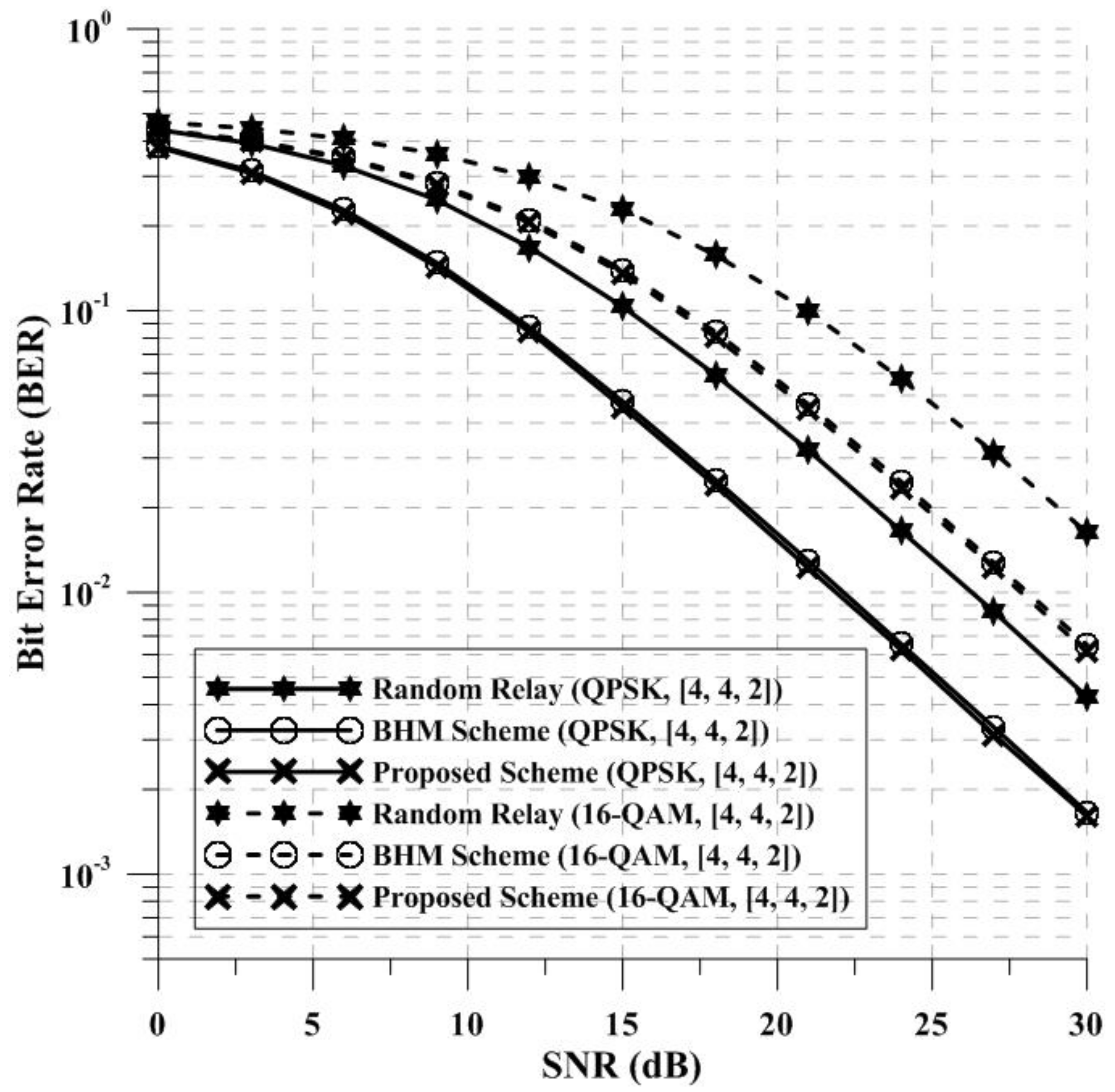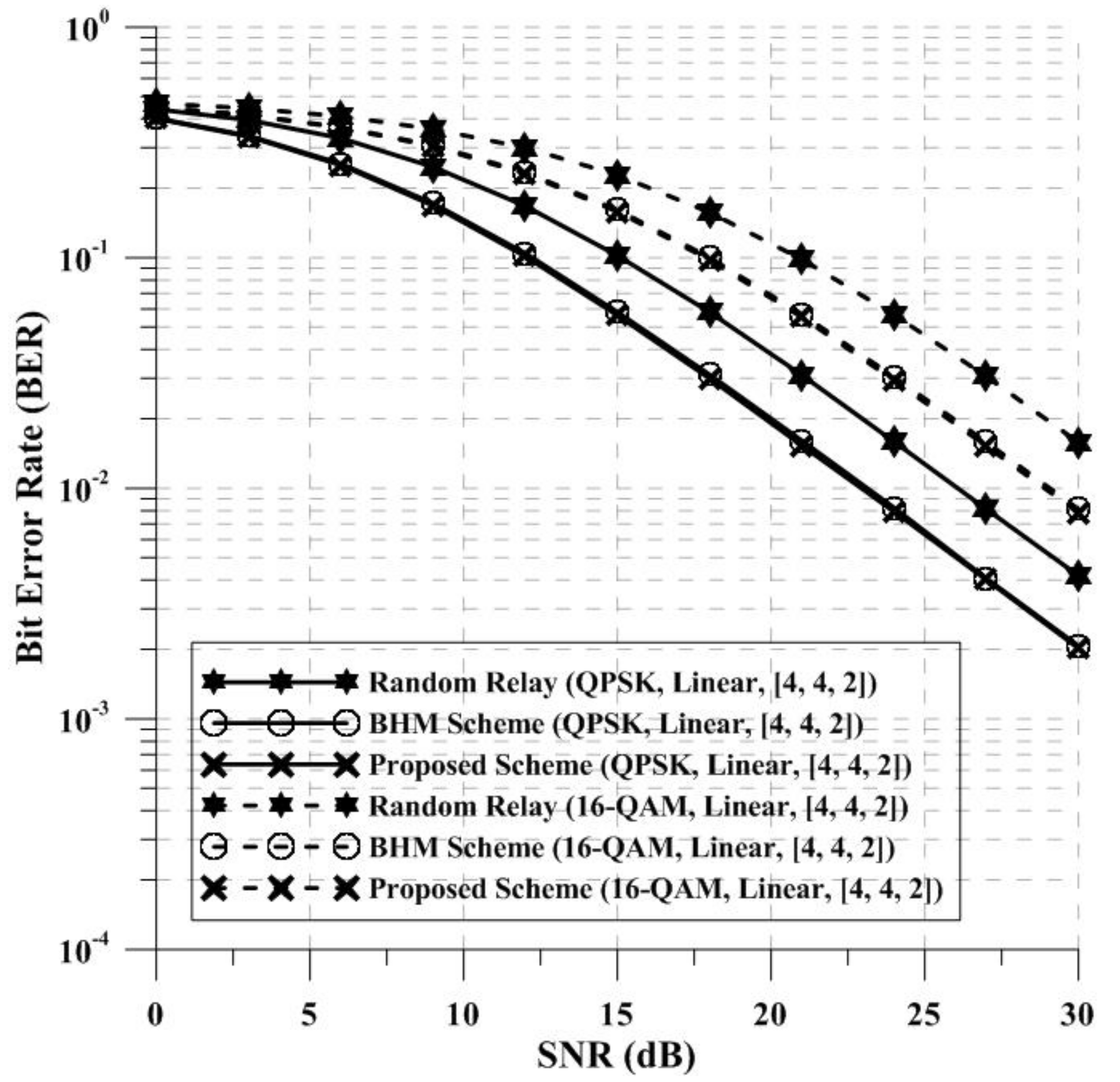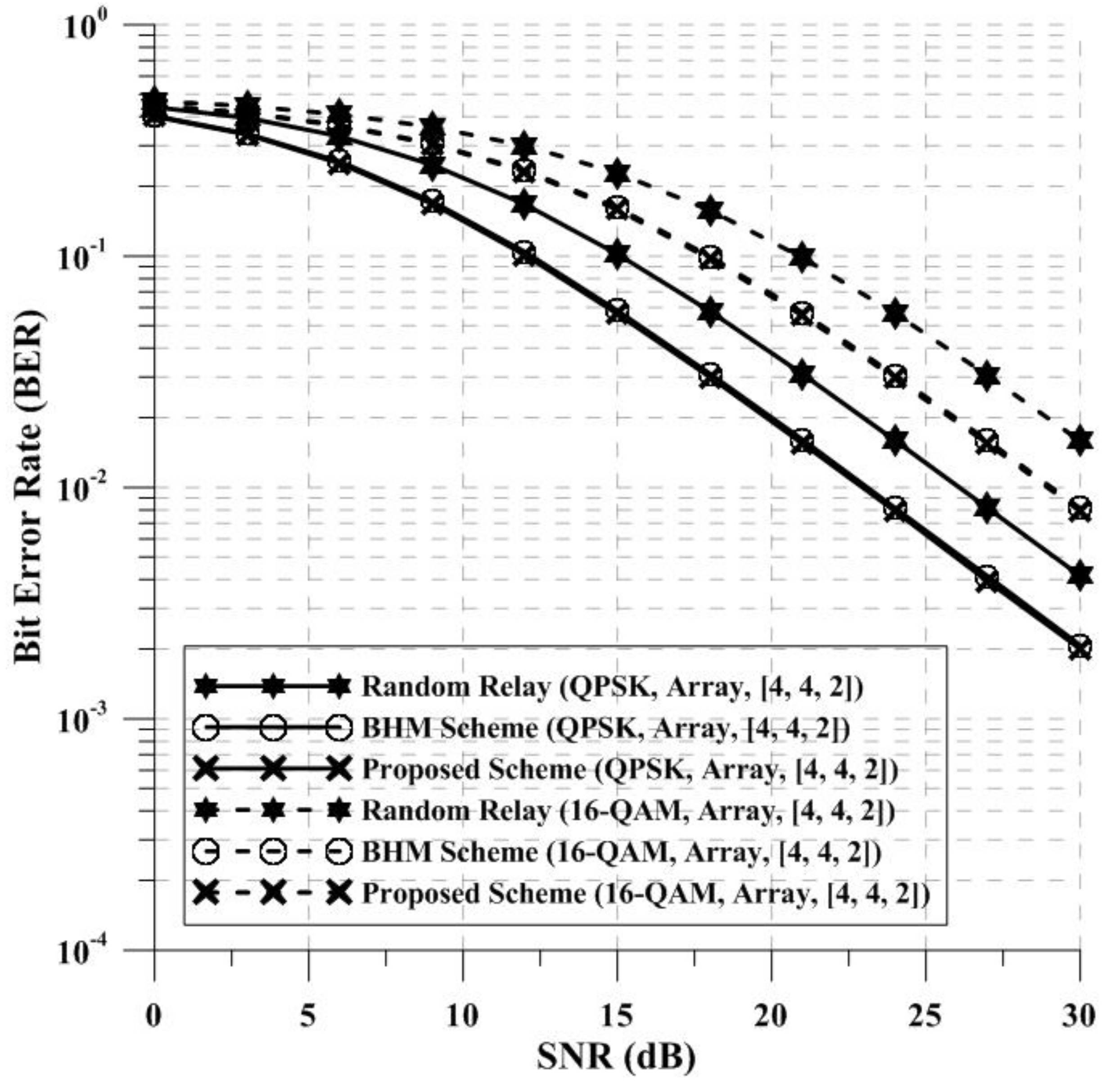1. Introduction
Recently, the multi user-multiple input multiple output (MU-MIMO) scheme plays an important role in increasing the average throughput of the cell and the throughput of the cell edge user in the long term evolution-advanced (LTE-A) [
1]. The MU-MIMO scheme can increase the channel capacity without additional bandwidth allocation by transmitting signals to multiple user equipment (UEs) at the same time [
2,
3]. In addition, since one base station (BS) simultaneously transmits signal to multiple UEs, the cell average throughput of the LTE-A communication system can be increased [
4]. There are many MU-MIMO schemes. Typical MU-MIMO schemes include channel inversion scheme and block diagonalization (BD) scheme. In the channel inversion scheme, the BS multiplies the transmission signal by the inverse matrix of the MIMO channel matrix between the BS and UE. Therefore, when the BS transmits the pre-coded signal, the UE receives the desired signal in which the interference signal is removed and only the noise is added. In the BD scheme, a pre-coding matrix is generated using the MIMO channel matrix between the BS and UE, and the BS transmits the signal multiplied by the pre-coding matrix. When the UE receives the pre-coding signal of the BD scheme, the UE receives the desired signal with the interference cancellation and only the noise is added, similar to the channel inversion scheme. Therefore, the MU-MIMO scheme is essential for increasing the cell average throughput of the LTE-A communication system. The sum capacity of the MU-MIMO channel is proved to be achieved by the dirty paper coding (DPC) which perfectly pre-subtracts the inter user interference (IUI). However, the DPC is difficult to apply to MU-MIMO system in practice, since the DPC requires additional complexity at the BS and UE. The BD scheme has been proposed to solve the high implementation complexity and nonlinear characteristic of DPC. Unlike the DPC, the BD scheme is a linear precoding scheme and its implementation complexity is very low. In addition, when there is no IUI, it is possible to approximately achieve the sum capacity that can be achieved by the DPC [
5]. Therefore, this paper adopts the BD scheme with low implementation complexity.
In order to obtain an appropriate performance evaluation of MIMO schemes, the usage of wireless channel model reflecting spatial channel characteristic is required [
6,
7]. Therefore, the 3rd generation partnership project (3GPP) proposed a 3-dimensional (3D) channel model through TR36.873 document. The 3D channel model proposed by 3GPP has additional parameters unlike the conventional 2-dimensional (2D) channel model. The large-scale parameters of the 3D channel model are shadow fading, delay spread, and angular spread. The small-scale parameters include delays, cluster power, angle-of-arrival (AOA), and angle-of-departure (AOD) [
8]. Among these parameters, the AOA can be used to estimate the localization of the UEs. There is a study related to AOA-based localization estimation using MIMO-OFDM channel state information (CSI) [
9]. In addition, the 3D channel model includes parameters related to polarization and antenna configuration (linear antenna, array antenna) [
10]. The proposed relay selection scheme can select appropriate relay in 3D channel as well as 2D channel.
The cell coverage is very important in wireless communication system such as LTE or LTE-A. As the distance between the BS and UE increases, the power of the transmitted signal is attenuated by the path loss. Thereby the received signal-to-noise ratio (SNR) is reduced. The reduction of the SNR of the received signal degrades the reliability of wireless communication systems such as the LTE or LTE-A. The multi-hop transmission system can overcome the above problem. The multi-hop transmission system can mitigate the power attenuation of the transmitted signal due to the path loss by using the relay between the BS and UE. As a result, the cell coverage of the wireless communication system can be expanded. There are amplify-and-forward (AF) relaying scheme and decode-and-forward (DF) relaying scheme in the typical multi-hop transmission schemes [
11]. In the AF relaying scheme, the relay receives a signal from the BS, and then amplifies the received signal, and transmits the amplified signal to the UE. Therefore, the signal processing in the relay is simple, but the noise is also amplified when the signal is amplified. In the DF relaying scheme, the relay receives a signal from the BS, and then the relay performs a decoding and detection. Then, the relay re-modulates the signal and forwards it to the UE. Therefore, the signal processing in the relay is complicated, but the noise is not amplified because the signal is not amplified [
12]. The proposed relay selection scheme adapts the DF relaying scheme. However, the DF relaying scheme has the error propagation problem that the error generated in a signal processing in the relay is transmitted to the UE [
13]. Therefore, the relay selection scheme is essential to mitigate the error propagation problem.
In the multi-hop transmission system, the relay selection scheme is essential. If an appropriate relay is not selected, the SNR of the received signal is reduced due to the effect of the error propagation problem. Therefore, the relay selection scheme is very important in a multi-hop transmission system using a relay [
14,
15]. There are many difficult relay selection schemes. Typical relay selection schemes include the random relay selection scheme, threshold-based relay selection scheme and best harmonic mean (BHM) scheme [
16]. The random relay selection scheme randomly selects one relay among several relays. In other words, the random relay selection scheme selects a relay without considering the SNR of the received signal and channel condition. Therefore, the random relay selection scheme is very simple, but it is possible to select a relay having a bad channel condition. It degrades the performance of the multi-hop transmission system. Then, one relay is randomly selected among the relay candidates. The BHM scheme is the optimal relay selection scheme. In the BHM scheme, a harmonic mean of the channel amplitude between the BS and relays and the channel amplitude between the relays and UE is obtained, and then the relay having the largest value is selected [
15]. Since the BHM scheme is an optimal relay selection scheme, it provides very high reliability, but it is very difficult to apply it to the actual system because the BS needs to know all channel information. The proposed relay selection scheme selects a relay using only the channel information between the BS and relays, which have the greatest influence on error propagation. Therefore, the proposed relay selection scheme can be applied to the actual system more easily than the BHM scheme because it only uses the channel information between the BS and relays.
This paper is organized as follows.
Section 2 shows the system model of the proposed relay selection scheme.
Section 3 explains the conventional relay selection schemes.
Section 4 describes the proposed relay selection scheme.
Section 5 shows the simulation results by comparing the conventional and proposed relay selection scheme. Finally,
Section 6 presents our conclusion.
3. Conventional Relay Selection Scheme
This section describes the conventional relay selection schemes. In the multi-hop transmission system, the relay selection scheme is essential. Especially, the relay selection scheme is very important in the DF scheme based multi-hop transmission system. If an appropriate relay is not selected, the error propagation problem can degrade the wireless communication reliability of the multi-hop transmission system. An alternative solution to the error propagation problem is to use more power at the base station. This alternative solution can increase the received SNR at the relay and reduce detection or decoding error. However, this method is very limited in cost because it requires an expensive amplifier. Therefore, the relay selection scheme is very important in the many studies related to the relay selection scheme.
3.1. Random Relay Selection Scheme
One of the typical relay selection schemes is the random relay selection scheme. The random relay selection scheme randomly selects the relay without considering factors such as the channel condition and SNR of the received signal. Therefore, the random relay selection scheme is very simple, and the relay for multi-hop transmission can be selected quickly. However, since the relay is randomly selected, the appropriate relay may not be selected. Since the relay having a bad channel condition can be selected, the error propagation problem is caused. In order to select the relay with good channel condition, other relay selection schemes have been studied in consideration of factors such as the channel condition and SNR of the received signal.
3.2. Best Harmonic Mean (BHM) Relay Selection Scheme
The best harmonic mean (BHM) relay selection scheme is a method for the selection of the optimal relay. The BHM relay selection scheme uses the harmonic mean of the channel amplitude between the BS and relays and channel amplitude between the relays and UEs. The harmonic mean of the two channel amplitudes is as follows:
where the
denotes the channel between the BS and relays, and the
refers to the channel between the relays and UEs. The
refers to the 2-norm (amplitude) of the channel matrix. The BS selects the relay with largest harmonic mean of the two channel amplitudes. Therefore, the BHM relay selection scheme can select the optimal relay. However, in the BHM relay selection scheme, the BS must know all channel information. Therefore, the BHM relay selection scheme is very complicated compared to other relay selection schemes, thus it is difficult to apply the scheme to the actual multi-hop transmission system.
5. Simulation Results
This section compares the BER performance of the proposed scheme with the conventional schemes through the BER performance graph according to the SNR. This simulation is based on the OFDM transmission scheme adopted in the LTE and LTE-A. The BER performance of the OFDM transmission scheme can be changed by time and frequency synchronization and channel coding. The BER performance sensitivity of OFDM transmission scheme according to time and frequency synchronization was studied in [
18,
19], and the performance changes according to channel coding was studied in [
20]. In addition, the analysis of OFDM performance for noise effects was studied in [
21]. The simulation parameters are as follows. The number of sub-carriers is 128, and the length of the cyclic prefix (CP) is 32. The modulation order is the quadrature phase shift keying (QPSK) and 16-quadrature amplitude modulation (16-QAM). It is assumed that the number of relay candidates is 20. In this simulation, two kinds of channel models are used. Since the conventional 2D channel model is assumed to be the non line-of-sight (NLOS) environment with seven-multi paths, this paper uses the Rayleigh fading channel with seven-multi paths [
22]. The 3D channel model is the 3D spatial channel model (3D SCM) proposed by the 3GPP.
Figure 5 and
Figure 6 show that the BER performance of the conventional schemes and proposed scheme in the 2D channel environment (7-multi paths Rayleigh fading channel). In
Figure 5 and
Figure 6, the [2, 2, 1] and [4, 4, 2] refer to the [BS antenna, relay antenna, UE antenna]. In case of the random relay, it has lowest BER performance because it selects one relay randomly among 20 relay candidates. Because each relay has different channel condition due to the distance of obstacles between the BS and relays, a relay having poor channel conditions can be selected in random relay selection scheme. The proposed relay selection scheme has the BER performance similar to that of the optimal relay selection scheme (BHM scheme). In the BHM scheme, the relay is selected by using both the channel information between the BS and relays and channel information between the relays and UEs, but the proposed relay selection scheme selects the relay using only the channel information between the BS and relays. In other words, the proposed relay selection scheme can select the appropriate relay more simply than the optimal relay selection scheme (BHM scheme).
As can be seen in
Figure 5, the BHM scheme in BER
has about 5 dB higher performance than the random relay selection scheme. The proposed scheme has similar BER performance with the BHM scheme in all SNR environments.
As shown in
Figure 6, even if the number of antennas of the BS, relays, and UEs is increased, the BHM scheme has approximately 5dB higher BER performance than the random relay selection scheme and the proposed relay selection scheme has similar BER performance with the BHM scheme in all SNR environments.
As shown in
Figure 5 and
Figure 6, the proposed relay selection scheme has similar BER performance with the optimal relay selection scheme (BHM scheme) and has better BER performance than the random relay selection scheme.
Figure 7 and
Figure 8 show the BER performance of the conventional schemes and the proposed scheme in the 3D channel (3D SCM) environment. In
Figure 7, the [4, 4, 2] refers to the [BS antenna, relay antenna, UE antenna], and ‘Linear’ means that the antennas of the BS and relays are linearly arranged
. As shown in
Figure 7, the random relay has the lowest BER performance because it selects one relay among 20 relays candidates. The proposed relay selection scheme has similar BER performance to the BHM scheme. In other words, the proposed relay selection scheme can select the appropriate relay using only the channel information between the BS and relays in the 3D channel environment. In
Figure 8, the ‘Array’ means that the antennas of the BS and relays are arranged in an array
. As shown in
Figure 8, the random relay has lowest BER performance, and the proposed relay selection scheme has BER performance similar to the BHM scheme. Therefore, the proposed relay selection scheme can select the appropriate relay using only 3D channel information between the BS and relays.
As shown in
Figure 7 and
Figure 8, the proposed scheme has similar BER performance with the optimal relay selection scheme (BHM scheme) and has better BER performance than the random relay selection scheme in 3D channel environment.
The proposed relay selection scheme has higher performance than the random relay selection scheme without considering any factors, since the proposed relay selection scheme selects an appropriate relay using the singular values of the channel matrix between the BS and relays. Additionally, in the BHM scheme (optimal relay selection scheme), the BS must know both the channel information between the BS and relays, and between the relays and UE. Therefore, the BHM scheme is an optimal relay selection scheme among the various relay selection schemes but it is very complicated. The proposed relay selection scheme selects one relay by using only the singular values of the channel matrix between the BS and relays. In other words, in the proposed relay selection scheme, even if the BS only knows the channel information between the BS and relays, an appropriate relay can be selected. As a result, the proposed relay selection scheme has similar BER performance of the BHM scheme, and can select an appropriate relay more easily than the BHM scheme.
The proposed relay selection scheme provides the method for selecting the appropriate relay by using only the channel information between the BS and relays, unlike the conventional schemes. Therefore, the proposed scheme can select the appropriate relay more simply than the conventional schemes. In addition, the proposed scheme can select the appropriate relay in the 2D channel and 3D channel environment. As a result, the proposed relay selection scheme can improve the reliability of the system by selecting the appropriate relay and mitigating the error propagation problem of the multi-hop transmission for MU-MIMO system.
